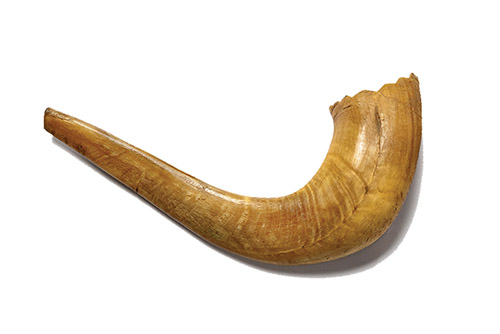
A shofar was sounded at the Museum of Jewish Heritage: A Living Memorial to the Holocaust, a week before Rosh Hashanah. Seventy-five years ago that same shofar was sounded in Auschwitz, and later that year aboard a steamship off the coast of Haifa when Chaskel Tydbor blew it after he caught sight of the Carmel Mountains. He and his fellow Holocaust survivors were about to enter the Promised Land after having survived the most horrific war imaginable.
In 1939, Tydbor had been interned in Buchenwald, then deported to Auschwitz and one of its 40 sub-camps, where he remained until January 1945. The ram’s horn had been entrusted to him by a fellow prisoner on the death march. Knowing he wouldn’t survive that march, which ended in Buchenwald, the man told him, “If you live, tell them we blew it in Auschwitz.”
It’s not only amazing that this artifact and the story behind it survived, but that it is not the only ritual object that survived the Nazis. In the concentration camps, to be discovered praying, individually or in groups, was to risk death. To own anything aside from what the Nazis allowed was to risk beatings and death. To observe fast days when the meager food rations were devised to kill you by starvation was illogical. To trade bread for empty matchbooks, as the Bobover rabbi did, so he could record the dead to keep their surviving wives from becoming agunot surely seemed, to some, pure folly. To abstain from eating your daily ration of bread on Passover, to sacrifice a valuable potato and a bit of margarine to create a menorah for Chanukah, all speak to the faith and determination of Jews during the Shoah. It was not necessarily a bad bargain. Without faith or hope, survival was practically impossible, and spiritual resistance took many forms.
There is a testimony from a survivor about his forced journey to one of the camps. He was in a crowded cattle car. Sabbath was approaching and an elderly woman took out her candlesticks and candles. A commotion ensued. Under the conditions, the whole car could become an inferno. But the woman hadn’t missed a Sabbath in 70 years and wasn’t about to begin. Over objections and threats, she lit and blessed the candles. A hush fell over the train, then came the prayers and singing. Observant or secular, they all felt the presence of the Sabbath Queen. For the few who survived, it was a transcendent memory.
Thanks to Dr. Judith Tydbor Schwartz, a professor at Bar Ilan University, the shofar, which remained in her family, is on loan to the museum for their exhibit, “Auschwitz, Not Long Ago, Not Far Away.” It is the first time it has ever been displayed. Like many survivors, her father was rather reticent about the Holocaust. Fortunately, we have a plethora of testimonies, written and recorded, as well as a massive number of documents created by the perpetrators themselves, and artifacts to offer a clear view to an historical event of such magnitude that it is beyond imagination and understanding. It is an event that defies belief.
In Liberty State Park, which overlooks the Hudson River, stands a bronze statue by Nathan Rapaport, who fled his native Poland ahead of the Holocaust. It depicts a 15-foot American GI holding a crumpled survivor in his arms. Buried beneath it is a time capsule, and in that time capsule is a piece of cloth, cut from a uniform. The survivor who had worn it at the end of her five-and-a-half year struggle to endure kept her grey and blue striped dress when she left Poland. On two separate occasions, a loaded gun was pointed at her head. The first time, the German, for no apparent reason, changed his mind. Another time, the gun jammed, and that soldier just let her ago. Perhaps he had fulfilled his quota for murdering Jews that day. The survivor knew that in years to come, she would never believe that she had survived those terrors without tangible evidence that she could see and touch.
The shofar from Auschwitz will be at the museum throughout this extraordinary exhibit as part of more than 1,000 unusual artifacts and photographs. For the High Holidays it will be moved to two synagogues and will be sounded. The worshippers who hear it will undoubtedly have an exceptional experience. Those of us who will not have been privileged to see that shofar before Rosh Hashanah can, from our own houses of worship, take a moment to consider it and its long journey to the museum. It is a story of Jewish courage, resourcefulness and resilience that has sustained Jews from the Akedah until today. May Abraham and Isaac’s unswerving faith always empower and continue to inspire their descendants.
By Barbara Wind









